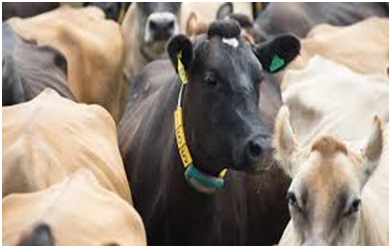Introduction
For successful economic return in the dairy and meat industry, breeding of the productive stock is paramount and thus dependent on effective heat detection in large animals where artificial insemination is widely practiced; it is one of the most important limiting factors for better reproductive efficiency. It is very critical to recognize that each missed heat is equivalent to 21 days loss and production. As it is a labor-intensive and time-consuming method, success depends on the abilities, skill, approach, and attitude of dairy farm workers. The overall reproductive efficiency of the farm depends on, how soon after calving, the cow comes into heat and the success of first or subsequent insemination as the ultimate goal of heat detection is to predict the actual time of ovulation so that an accurate time of insemination is planned for better conception rate. Heat detection directly affects calving interval and milk production thus; it can significantly increase the profit of a dairy farm. The traditional method has been based on visual observation of the animals but over the year’s many advancements came into the field which has added to the basic knowledge of effective heat detection that led to significant improvement in conception rate especially in large animals after artificial insemination. There are various techniques for heat detection in farm animals.
Observation Visually
It is the most common method of heat detection in large animals which is dependent on observable signs exhibited by individual animals like frequent urination, separation from herd, chin resting, back rubbing, nervousness, restlessness, walking along fences, bawling, aggression, bellowing arching back, loss of appetite and sudden drop in milk production, licking, sniffing, head lift up, lip curling and flehman’s reaction after touching the genitalia, tumefaction of the vulva, reddening of vulva, mucus discharge, closeness in animals coming into heat usually Congregates and form small groups of three to five animals called sexually active groups, postural alteration facilitates mating called sexual presentation for several seconds. Each observation period must be sufficiently long usually 30 minutes to be effective.
Teaser bull:
The bull whose internal reproductive tract has been altered with a specific purpose i.e. the bull should be able to detect the animals in the heat but cannot deposit the semen into the reproductive tract or female; this can be done either by vasectomy or caudal
epididymectomy. They are commonly known as vasectomized bulls used to aid in heat detection where hear detection rates are as high as 84 percent.
Ferning pattern:
Cervical mucus secreted during estrus is collected and smeared on the slide, after drying if it shows more branching, it is considered appropriate for breeding.
Expected Heat and records:
Heat expectancy charts are prepared on the basis of the last heat so that the expected next date may be calculated and particular animals are viewed closely for the exhibition of any heat symptom. It is simple managemental tool helping in the detection of heat in bovines.
Identification using paints:
Oil or water-based paints are applied on to the back of a cow’s spine were most often rubbed by the brisket of the mounting companion cow.
Chin-ball markers:
Bulls are used as marker animals and they are fitted with ball marking devices when such bull mounts on animals in estrus the chin presses down on the back or rump of the cow then spring in the device is pressed and the marker fluid is released and the mark can be seen on the rump or back of the animal.
Pedometers:
The activity of the individual animal is monitored and recorded through a devise and data is analyzed. The animal experiencing the estrous cycle will show more activity compared to herd mates during the same period. Animals showing more activities are separated and confirmed for true heat.
Heat mount detector:
It is a device that senses mounting activity and sends these signals to the receiver for further analysis. A cow is declared to be in heat if she shows mounting 3 times within 4 hours.
Per rectal examination of the genitalia:
During estrus, the tonicity of the uterine horns increase significantly which remains different than pregnancy. Cervix become loose under the influence of estrogen hormone secreted in large quantities during estrus. After proper detection of heat, the standard AM/PM rule is followed for insemination which gives satisfactory results under field conditions.

Mohit Mahajan1, Shiv Prasad2, and Gaurav Tevatia3
1PhD Scholar, Department of Veterinary Gynaecology and Obstetrics, College of Veterinary and Animal Sciences, GBPUAT, Pantnagar, Uttarakhand 263145
2Professor, Department of Veterinary Gynaecology and Obstetrics, College of Veterinary and Animal Sciences, GBPUAT, Pantnagar, Uttarakhand 263145
3MVSc Scholar, Department of Veterinary Gynaecology and Obstetrics, College of Veterinary and Animal Sciences, GBPUAT, Pantnagar, Uttarakhand 263145
*Corresponding author- mohitmahajan108@gmail.com















